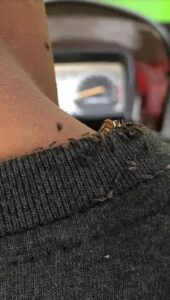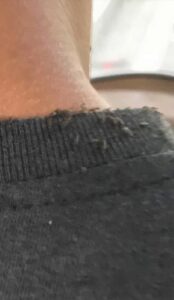The Filipino online community is alarmed and concerned after a startling video of a tricycle driver with a severe head lice infestation went viral on social media. The now-deleted video, which was first shared on Facebook by Primo Onipa, attracted a lot of attention since it sought to draw attention to the grave dangers of untreated lice infestations, particularly for people who regularly engage with the public.
A severe case of infestation is seen in the video, as lice are visible creeping across the back of the driver’s neck and onto his shirt. This severe illness is a sobering reminder of the value of personal cleanliness, particularly for those in high-contact occupations like driving who interact with commuters on a daily basis.
The video’s uploader, Onipa, posted it to shock others and spread awareness of the risks of poor hygiene. He advised other tricycle drivers and those in related occupations to put cleanliness first. Onipa wrote, “Let’s remember to maintain good hygiene.” “We need to protect ourselves and others because we interact with a lot of commuters every day.”
Online debates concerning the significance of treating head lice and the negative health effects of neglecting infestations were spurred by the film.

In his video commentary, Dr. Jay Recasata of the Faces and Curves clinic discussed the risks associated with severe head lice infestations. When Dr. Recasata said, “Head lice are highly contagious and can spread quickly,” They reproduce quickly, feed on blood, and flourish at the roots of our hair. In severe situations, they may result in scalp wounds that harbor bacteria.
Lice infestations may be treated, but ignoring them can have major negative health effects, Dr. Recasata stressed. He clarified, “Treatment is relatively simple,” “All you need is a special medicated shampoo, which costs about P500 per bottle. However, if the infestation gets out of control, lice can lead to problems like anemia and malnutrition. Similar to this, Dr. Enrique Collantes of Derma Clinic cautioned that because lice feed on the blood of their hosts, persistent infestations may have a negative effect on general health.
According to the National Health Service (NHS), direct contact with an infected person is usually how head lice are transmitted. But sharing personal belongings like hats, brushes, and combs can also help the spread. Furthermore, if surfaces like bedding, towels, and upholstered furniture are not adequately cleaned, lice may be able to live there for a short time and cause additional contamination.
Medical professionals advise practicing proper personal cleanliness and taking the following actions to avoid lice infestations: Use hot water to wash towels, blankets, and clothing. To get rid of any potential lice, vacuum the floors and upholstered furniture. To get rid of lice or their eggs, soak combs, brushes, and hair accessories in hot water for at least five to ten minutes.

Because they come into contact with a lot of people on a daily basis, drivers, commuters, and those in positions that need them to engage with the public should be especially careful to adhere to these hygiene guidelines.
In occupations where regular interaction with others is inevitable, this incidence has spurred extensive conversations regarding hygiene. During their shifts, tricycle drivers frequently interact closely with people, just as many other public servants. By keeping things clean, they not only protect their own health but also the health of other passengers and the community at large.
The startling video has spurred crucial discussions about health hazards and hygiene that are frequently overlooked. Do you know someone who has experienced a lice infestation? How do you take preventative measures against them? Tell us what you think! This tale is an important reminder that keeping oneself clean is important for one’s health and safety, not simply for one’s appearance.
